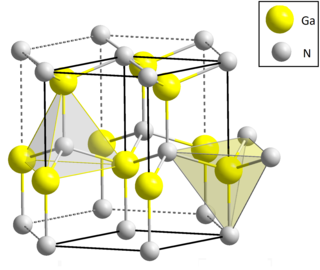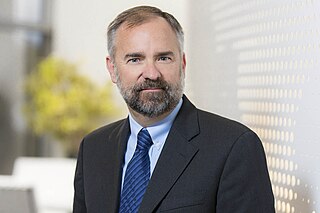Related Research Articles
A thin-film transistor (TFT) is a special type of field-effect transistor (FET) where the transistor is made by thin film deposition. TFTs are grown on a supporting substrate, such as glass. This differs from the conventional bulk metal oxide field effect transistor (MOSFET), where the semiconductor material typically is the substrate, such as a silicon wafer. The traditional application of TFTs is in TFT liquid-crystal displays.

Gallium nitride is a binary III/V direct bandgap semiconductor commonly used in blue light-emitting diodes since the 1990s. The compound is a very hard material that has a Wurtzite crystal structure. Its wide band gap of 3.4 eV affords it special properties for applications in optoelectronic, high-power and high-frequency devices. For example, GaN is the substrate that makes violet (405 nm) laser diodes possible, without requiring nonlinear optical frequency doubling.
Carver Andress Mead is an American scientist and engineer. He currently holds the position of Gordon and Betty Moore Professor Emeritus of Engineering and Applied Science at the California Institute of Technology (Caltech), having taught there for over 40 years.

Alec Nigel Broers, Baron Broers, is a British electrical engineer.

Sir Charles William Oatley OBE, FRS FREng was Professor of Electrical Engineering, University of Cambridge, 1960–1971, and developer of one of the first commercial scanning electron microscopes. He was also a founder member of the Royal Academy of Engineering.
Ghavam G. Shahidi is an Iranian-American electrical engineer and IBM Fellow. He is the director of Silicon Technology at the IBM Thomas J Watson Research Center. He is best known for his pioneering work in silicon-on-insulator (SOI) complementary metal–oxide–semiconductor (CMOS) technology since the late 1980s.

Supriyo Datta is an Indian–American researcher and author. A leading figure in the modeling and understanding of nano-scale electronic conduction, he has been called "one of the most original thinkers in the field of nanoscale electronics."
Donal Donat Conor Bradley is the Vice President for Research at King Abdullah University of Science and Technology (KAUST), Saudi Arabia. From 2015 until 2019, he was head of the Mathematical, Physical and Life Sciences Division of the University of Oxford and a Professor of Engineering Science and Physics at Jesus College, Oxford. From 2006 to 2015, he was the Lee-Lucas Professor of Experimental Physics at Imperial College London. He was the founding director of the Centre for Plastic Electronics and served as vice-provost for research at the college.

Sorab (Soli) K. Ghandhi was a professor Emeritus at Rensselaer Polytechnic Institute (RPI) known for his pioneering work in electrical engineering and microelectronics education, and in the research and development of Organometallic Vapor Phase Epitaxy (OMVPE) for compound semiconductors. He was the recipient of the IEEE Education Award "For pioneering contributions to semiconductor and microelectronics education" in 2010.
Mark S. Lundstrom is an American electrical engineering researcher, educator, and author. He is known for contributions to the theory, modeling, and understanding of semiconductor devices, especially nanoscale transistors, and as the creator of the nanoHUB, a major online resource for nanotechnology. Lundstrom is Don and Carol Scifres Distinguished Professor of Electrical and Computer Engineering and in 2020 served as Acting Dean of the College of Engineering at Purdue University, in West Lafayette, Indiana.
Henning Sirringhaus is Hitachi Professor of Electron Device Physics, Head of the Microelectronics Group and a member of the Optoelectronics Group at the Cavendish Laboratory. He is also a Fellow of Churchill College at the University of Cambridge.

John Robertson FRS is a Professor of Electronics, in the Department of Engineering at the University of Cambridge. He is a leading specialist in the theory of amorphous carbon and related materials.
Jean-Pierre Leburton is the Gregory E. Stillman Professor of Electrical and Computer Engineering and professor of Physics at the University of Illinois at Urbana–Champaign. He is also a full-time faculty member in the Nanoelectronics and Nanomaterials group of the Beckman Institute for Advanced Science and Technology. He is known for his work on semiconductor theory and simulation, and on nanoscale quantum devices including quantum wires, quantum dots, and quantum wells. He studies and develops nanoscale materials with potential electronic and biological applications.
James F. Gibbons is an American electrical engineer and academic administrator. He is credited with starting the semiconductor device fabrication laboratory at Stanford University that enabled the semiconductor industry and created Silicon Valley.

Dr. Gary Patton is an American technologist and business executive. He is currently the Corporate Vice President and General Manager of Design Enablement and Components Research in the Technology Development Group at Intel. He has spent most of his career in IBM, starting in IBM's Research Division and holding management and executive positions in IBM's Microelectronics Division in Technology Development, Design Enablement, Manufacturing, and Business Line Management.

Tsu-Jae King Liu is an American academic and engineer who serves as the Dean and the Roy W. Carlson Professor of Engineering at the UC Berkeley College of Engineering.
David Attwood is an American physicist and professor emeritus at the University of California, Berkeley, where he worked in the field of synchrotron radiation and free-electron lasers, developing X-ray microscopy techniques for research and for the industry. He is the author of a reference book on soft X-rays and extreme ultraviolet radiation.

Aristos Christou is an American engineer and scientist, academic professor and researcher. He is a Professor of Materials Science, Professor of Mechanical Engineering and Professor of Reliability Engineering at the University of Maryland.

Nir Tessler is the Barbara and Norman Seiden professor in the Faculty of Electrical and Computer Engineering and head of the Microelectronics and Nanoelectronics centers at the Technion - Israel Institute of Technology.

Sandip Tiwari is an Indian-born electrical engineer and applied physicist. He is the Charles N. Mellowes Professor of Engineering at Cornell University. His previous roles were Director of National Nanotechnology Users Network, Director of the National Nanotechnology Infrastructure Network, and research scientist at IBM T. J. Watson Research Center. He is best known for his pioneer research in the fields of SiGe transistor and nanocrystal memory.
References
- 1 2 3 4 "AHMED, Prof. Haroon" . Who's Who . Vol. 2015 (online Oxford University Press ed.). A & C Black.(Subscription or UK public library membership required.)
- 1 2 3 4 Ahmed, Haroon (2013). Cambridge Computing: The First 75 years (PDF). London: Third Millennium Publishing Limited. p. 176. ISBN 9781906507831. Archived from the original (PDF) on 18 March 2015.
- 1 2 "List of Fellows". Archived from the original on 8 June 2016. Retrieved 10 October 2014.
- ↑ Hopper, A.; Jones, A.; Augur, R. A.; Fice, M. J.; Blythe, S.; Ahmed, H. (1992). "A feasibility study for the fabrication of planar silicon multichip modules using electron beam lithography for precise location and interconnection of chips". IEEE Transactions on Components, Hybrids, and Manufacturing Technology. 15: 97–102. doi:10.1109/33.124197.
- 1 2 Haroon Ahmed's publications indexed by the Scopus bibliographic database. (subscription required)
- ↑ Wharam, D. A.; Thornton, T. J.; Newbury, R.; Pepper, M.; Ahmed, H.; Frost, J. E. F.; Hasko, D. G.; Peacock, D. C.; Ritchie, D. A.; Jones, G. A. C. (1988). "One-dimensional transport and the quantisation of the ballistic resistance". Journal of Physics C: Solid State Physics. 21 (8): L209. Bibcode:1988JPhC...21L.209W. doi:10.1088/0022-3719/21/8/002.
- ↑ Thornton, T.; Pepper, M.; Ahmed, H.; Andrews, D.; Davies, G. (1986). "One-Dimensional Conduction in the 2D Electron Gas of a Ga As-Al GaAs Heterojunction". Physical Review Letters. 56 (11): 1198–1201. doi:10.1103/PhysRevLett.56.1198. PMID 10032595.
- ↑ Sato, T.; Ahmed, H.; Brown, D.; Johnson, B. F. G. (1997). "Single electron transistor using a molecularly linked gold colloidal particle chain". Journal of Applied Physics. 82 (2): 696. Bibcode:1997JAP....82..696S. doi: 10.1063/1.365600 .
- ↑ Corpus Christi College - Haroon Ahmed [ permanent dead link ]
- ↑ interviewed by Alan Macfarlane 8 December 2009 (video)
- ↑ Ahmed, Haroon (1963). Studies on high-current-density thermionic cathodes (PhD thesis). University of Cambridge.
- ↑ He, J.; Durrani, Z. A. K.; Ahmed, H. (2004). "Universal three-way few-electron switch using silicon single-electron transistors" (PDF). Applied Physics Letters. 85 (2): 308. Bibcode:2004ApPhL..85..308H. doi:10.1063/1.1772526. hdl: 10044/1/13742 .